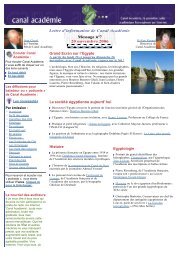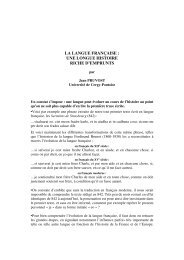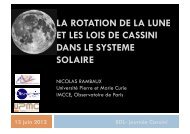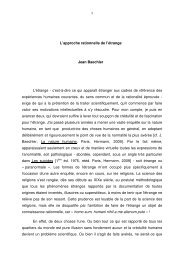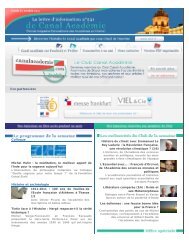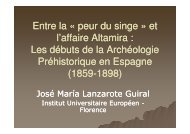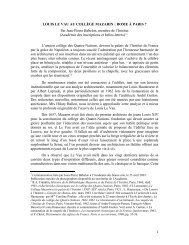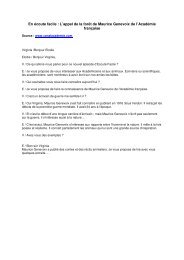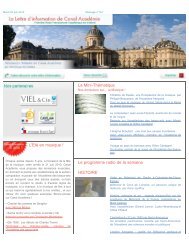(Microsoft PowerPoint - Acad\351mie_08.ppt [Lecture seule])
(Microsoft PowerPoint - Acad\351mie_08.ppt [Lecture seule])
(Microsoft PowerPoint - Acad\351mie_08.ppt [Lecture seule])
Create successful ePaper yourself
Turn your PDF publications into a flip-book with our unique Google optimized e-Paper software.
Mixing impurities A and B with opposite or similar spin asymmetries:the pre-concept of GMRspinExample: Ni + impurities A and B (Fert-Campbell, 1968, 1971)1st case2d caseα = ρα A > 1, α B < 1 ↓ /ρ ↑α A and α B > 1High mobility channel low ρspinspinspinρ AB >> ρ A + ρ Bρ AB ≈ ρ A + ρ BJ. de Physique 32, 1971
Epitaxie par jet moléculaire(croissance de multicouches métalliques)
•Multicouches magnétiquesFeCrFeCrFe
•Multicouches magnétiquesAimantations descouches de Fe à champ nuldans des multicouches Fe/CrFeCrFeCrFeP. Grünberg, 1986 → couplage antiferromagnétique entre couches
•Multicouches magnétiquesAimantationsaprés applicationd’un champmagnétiqueFeHCrFeCrFeP. Grünberg, 1986 → couplage antiferromagnétique entre couches
• Magnetoresistance Géante (GMR)(Orsay, 1988, multicouches Fe/Cr, Jülich, 1989,tricouches Fe/Cr/Fe)OrsayJülich~ + 80%Magnetic field (kGauss)V=RICourantAP (AntiParallèle) P (Parallèle)
• Magnetoresistance Géante (GMR)(Orsay, 1988, multicouches Fe/Cr, Jülich, 1989,tricouches Fe/Cr/Fe)Aimantations anti-parallèles(champ nul, forte résistance)~ + 80%FeCrFeAimantations parallèles(champ appl., petite resist.)Magnetic field (kGauss)FeCrFecourantCourantAP (AntiParallèle) P (Parallèle)Condition pour GMR:épaisseurs ≈ nm
GMR oscillations in Co/Cu (Orsay 1991, Mosca, AF et al)
• Magnetoresistance Géante (GMR)(Orsay, 1988, multicouches Fe/Cr, Jülich, 1989,tricouches Fe/Cr/Fe)Aimantations anti-parallèles(champ nul, forte résistance)~ + 80%FeCrFeAimantations parallèles(champ appl., petite resist.)Magnetic field (kGauss)FeCrFecourantCourantAP (AntiParallèle) P (Parallèle)Condition pour GMR:épaisseurs ≈ nm
Tête de lecturede disque durpisteS N S NS NN S N S N SN SS N5 nmElément GMR(multicouchemagnétique)
• Enregistrement magnétique: évolution des densités surfaciques(de l’AMR à la GMR)2008600 Gb/in 21 disque dur de 400 Giga-octet peut contenir une information équivalenteà environ 800.000 livres (format livre de poche)ou à 1 million de photographies (de définition moyenne)ou à 8000 CD audio (compression MP3)ou à 300 heures video, ou 36 heures video haute def.
• Enregistrement magnétique: Disque 5 GB Microdrive
Analyse biologique« biochips »quelques microns( prototypes avecréseaux de capteurspour détecter unmillier de ciblesdifférentes)
• Magnetic Tunnel Junctions,Tunneling Magnetoresistance (TMR)ferromagneticelectrodesJullière, 1975,low T, hardlyreproducible≈ 0.1 µmPLow resistance statetunnelingbarrier(insulator)~ 100 nmAPHigh resistance stateMoodera et al, 1995, Miyasaki et al,1995, CoFeCoFe/Al/Al2O3/CoCo, MR ≈3030-40%Applications: - read heads of Hard Disc Drive- M-RAM (Magnetic Random Access Memory)MRAM: density/speed ofDRAM/SRAM +nonvolatilty + lowenergy consumption
1)Epitaxial magnetic tunnel junctions (MgO, etc)First examples on Fe/MgO/Fe(001):CNRS/Thales (Bowen, AF et al, APL2001)Nancy (Faure-Vincent et al, APL 2003)Tsukuba (Yuasa et al, Nature Mat. 2005)IBM (Parkin et al, Nature Mat. 2005)….etcYuasa et al, Fe/MgO/FeNature Mat. 2005∆R/R = (R AP -R P )/ R P ≈ 200% at RT2006-2007CoFeB/MgO/CoFeB,∆R/R ≈ 500% at RT in severallaboratories in 2006-2007+Clearer picture of thephysics of TMR:what is inside the word« spin polarization »?
2) Directions pour une TMR plus élevéeFerromagnétiquesà polarisation en spin 100% (composésdemi-metalliquesmetalliques)Exemple: La 2/3 Sr 1/3 MnO 3 (LSMO)jonctions tunnel LSMO/SrTiO 3 /LSMO (CNRS/Thales): TMR de 1800%correspondant à 95% de polarisation de spinLa 2/3 Sr 1/3 MnO 3SrTiO 3La 2/3 Sr 1/3 MnO 3Image de microscopie électronique par J-L. Maurice, UMR CNRS/Thales
Transfert de spin(renversement d’aimantation, génération de micro-ondes)Spintronique avec semi-conducteursSpintronique moléculaire
Transfert de spin(renversement d’aimantation, génération de micro-ondes)Spintronique avec semi-conducteursSpintronique moléculaireIntroduction:accumulation de spinet courant de spin
Co/Cu: Current in Plane (CIP)-GMR(Mosca, AF et al, JMMM 1991)6 nmCIP-GMRscaling length = mean free pathMR ratio (%)108642060 nmCo/Cu: Current ⊥ to Plane (CPP) GMR( L.Piraux, AF et al, APL 1994,JMMM 1999)400 nm0 100 200 300 400 500Co thickness (nm)CPP-GMRscaling length = spin diffusion length>> mean free pathspin accumulation theory,(Valet-Fert, PR B 1993)
Spin injection/extraction at a NM/FM interface (beyond ballistic range)NMSpin accumulation∆µ= E -E F↑ F↓zone of spinaccumulationNMl sfEE F↑FMl sfFM= spin↑ chemical potential(illustration in the simplestcase = flat band, low current,no interface resistance,single polarity)F Mls f = spin diffusion length in FMl s fN M= spin diffusion length in NM(example: 0.5 µm in Cu,>10µm in carbonnanotube)E -E F↑ F↓ ~ exp(z/ F Ml ) in FMs fzE F↑E F↓= spin↓ chemical potentialE -E F↑ F↓ ~ exp(-z/ N Ml ) in NMs fSpin current= J ↑ -J ↓N Ml s fFMl sfJ ↑ -J ↓J ↑ +J ↓= current spin polarizationz
Spin injection/extraction at a Semiconductor/FM interfaceNM = metal orsemiconductorzone of spinaccumulationNMl sfFMl sfFM1) situation withoutinterface resistance(« conductivity mismatch »)(Schmidt et al, PR B 2000)Spin accumulation∆µ= E -E F↑ F↓EE F↑Semiconductor/ / F metalIf similar spin spliting on both sides butmuch larger density of states in F metalzSpin current= J ↑ -J ↓zNM= metalN Ml s fE F↑E F↓FMl sfNM =semiconductormuch larger spin accumulation densityand much more spin flipson magnetic metal sidealmost complete depolarization ofthe current before it enters the SC
Spin injection/extraction at a Semiconductor/FM interfaceNM =semiconductorFMN MFMl s fl sfzE F↑E F↓Current SpinPolarization(J -J ↑ ↓ )/(J ↑ +J ↓ )Spin accumulation∆µ= E -E F↑ F↓spin dependent. interf.resist. (ex:tunnel barrier)Spin dependent drop of theelectro-chemical potentialDiscontinuity increases thespin accumulation in NMre-balanced spin relaxationsin F and NME F↑E F↑*Nrb≈ rN= ρ N lsfRasbah, PR B 2000e -extension of the spinpolarizedcurrent into thesemiconductorA.F-Jaffrès, PR B 2001
Concept du transfert de spin (Slonczewski 1996)SF 1F 2≈ 0.1 µmComposantetransverseLa composante transverse du spin est perdue par lesélectrons du courant, mais est en fait transférée auSPIN global S de la couche rotation de SS
Experiments on pillarsAuFree ferroCuFixedferroI - Cu V -4 nm10 nmMetallic pillar ≈ 50x150 nm²Au100 nmAuTa (5 nm)Cu (15nm)Pt (3nm)[Co/Ni] (3 nm)Cu (4nm)[Co/Pt]/[Co/Ni] (4nm)Pt (3nm)Free ferrobarrierFixedferroI - Cu V -Tunnel junction4 nm10 nmE-beam lithography + etchingCu (35nm)Ta (5 nm)courtesy of S. ManginUniversity of Nancy
Experiments on pillarsAuFree ferroCuFixedferroI - Cu V -4 nm10 nmMetallic pillar ≈ 50x150 nm²Free ferrobarrierFixedferroAuI - Cu V -Tunnel junction4 nm10 nma) First regime (lowH):irreversible switching(CIMS)b) Second regime (highH):steady precession(microwave generation)E-beam lithography + etching
MzRegime of irreversible magnetic switchingFirst experiments on pillars:Cornell (Katine et al, PRL 2000)CNRS/Thales (Grollier et al, APL 2001)IBM (Sun et al, APL 2002)Py/Cu/Py 50nmX150nm (Boulle, AF et al)14,60.10.0-0.1H=7 OeRTAP-1.0-0.50.0Mx0.51.0m-1.0AP stateof mP1.00.50.0-0.5550000MyGaMnAs/InGaAs/GaMnAstunnel junction (MR=150%)(Elsen, AF et al, PR B 2006)30 KMP stateof mdV/dI (Ω)14,514,4Py = permalloyAPP-2 0I (m A)Resistance (Ω)500000450000400000typical switching current ≈ 10 7 A/cm 2switching time can be as short as 0.1 ns (Chappert et al)-1.0x10 5 -5.0x10 4 0.0 5.0x10 4 1.0x10 5Current density (A.cm -2 )1 x 10 5 A/cm 2
Regime of steady precession (microwave frequency range)dV/dI (Ω)AP15,615,014,4CNRS/Thales, Py/Cu/PY (Grollier et al)(Py = permalloy)-4 0HMI (mA)5600G9GPower (pW/GHz)32103,5 4,0Frequency (GHz)H dPmM z0.50.0-0.5-1.0-0.5Mx0.00.5Hm0.0-0.51.0 -1.00.5My1.0M z0.50.0-0.5-1.0-0.5MxH d0.5H b0.0H m d1.00.5 -0.50.0-1.00.0-0.50.51.0 -1.0M yIncreasing currentMz-0.5Mx0.00.5m1.0H-0.5-1.01.00.50.0My
Co/Cu/Py (« wavy » angular variationcalculated by Barnas, AF et al, PR B 2005)100x170nm²Aufree Py:fast spinrelaxationfixed Co: slower spinrelaxationPower (pW/GHz)3020100H = 2 Oe H ≈ 0 (2 Oe)Py (8nm, free)Cu ( 8nm)Co (8nm, fixed)IrMn (15nm)or CoO or Cu9,5 mA9 mA8,5 mA8 mA7,5mA7 mA6,5 mA6 mAdV/dI (Ω)15,615,014,41.5 2.0 2.5 3.0 3.5Boulle, AF et al,Frequency (GHz) Nature Phys. 2007oscillations at H=0Py/Cu/Py (standard)5600G9G-4 0I (mA)Negative I (mA)H ≈ 0Positive I
Application du transfert de spin: commutation de mémoiresMRAM et d’électronique logique reconfigurableAujourd’hui :commutation par unchamp magnetiqueappliqué de l’extérieur(non local)Demain, électroniquement° par transfusion de spinsCourantde spins
Advantages:Spin Transfer Oscillators (STO)(communications, microwave pilot)-directoscillation in the microwave range (5-40GHz)f/f∆f ≅ 18000-agilityagility: control of frequency by dc current amplitude,(frequency modulation , fast switching)- high quality factor- small size (≈(0.1µm)(on-chip integration)-oscillationswithout applied field-Needed improvements- - increase of power by synchronization of alarge of number N of STO ( x N 2 )Rippart et al,PR B70, 100406,2004
Synchronization of STOsSynchronization by exchange coupling (magnetic elasticity)- Kaka et al (NIST Boulder) Nature 2005(similar results by Freescale)Free magnetic layerFixed magnetic layerPhase locking of oscillations for r ≈ 500 nm
Experiments of STO synchronization by electrical connection(B.Georges, AF et al, CNRS/Thales and LPN-CNRS, preliminary results)trilayer 2hf circuitI dctrilayer 1


![(Microsoft PowerPoint - Acad\351mie_08.ppt [Lecture seule])](https://img.yumpu.com/41376561/1/500x640/microsoft-powerpoint-acad351mie-08ppt-lecture-seule.jpg)
